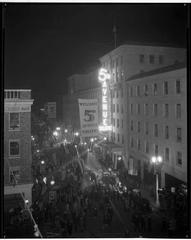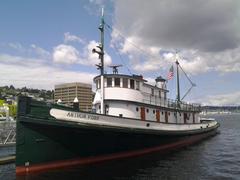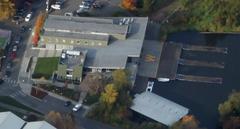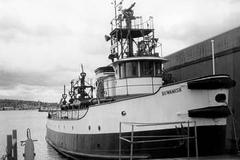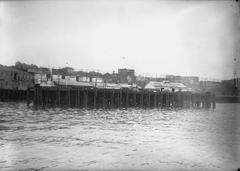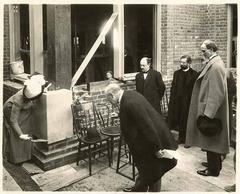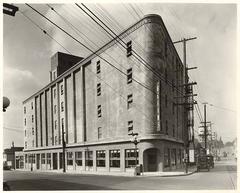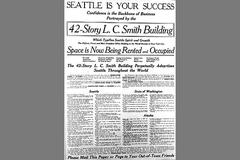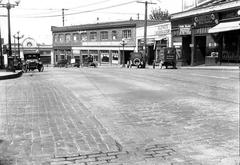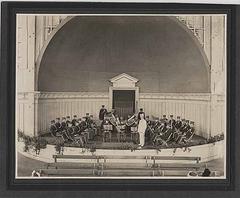
Paramount Theatre Seattle: Visiting Hours, Tickets, and Historical Significance
Date: 03/07/2025
Introduction
Nestled in downtown Seattle, the Paramount Theatre stands as a testament to the city’s rich cultural heritage and passion for the performing arts. Since its grand opening on March 1, 1928, the theatre has evolved from a silent movie palace and vaudeville stage into a premier destination for Broadway productions, concerts, comedy, and diverse live performances. Designed by Rapp and Rapp in the lavish French Renaissance style, its interiors—adorned with gold leaf, crystal chandeliers, and elaborate plasterwork—immerse visitors in the grandeur of the Roaring Twenties (HistoryLink; Seattle Broadway).
Over nearly a century, the Paramount has not only showcased world-class entertainment but has also played a pivotal role in Seattle’s cultural landscape, surviving financial hardships and near closure through a comprehensive restoration led by philanthropist Ida Cole. Today, the Paramount remains a beacon of historic preservation, community engagement, and artistic diversity (Microsoft).
This guide provides an in-depth look at the Paramount Theatre’s storied history, architectural brilliance, essential visitor information, and nearby attractions. Whether you’re an architecture enthusiast, a theater lover, or a curious traveler, the Paramount Theatre promises an enriching and memorable Seattle experience (Paramount Theatre Seattle).
Table of Contents
- Origins and Early Years (1928–1930s)
- Architectural Significance
- Mid-Century Evolution and Challenges
- Restoration and Revival (1990s–2000s)
- Notable Events and Performances
- Visitor Information
- Nearby Attractions
- Special Events and Guided Tours
- Visuals and Media
- Frequently Asked Questions (FAQ)
- The Paramount’s Role in Seattle’s Cultural Landscape
- Summary & Travel Tips
- References
Origins and Early Years (1928–1930s)
The Paramount Theatre, initially named the Seattle Theatre, opened on March 1, 1928, at the intersection of 9th Avenue and Pine Street. The vision of L. N. Rosenbaum and East Coast investors, the theatre was designed as both a silent-movie house and a vaudeville stage to meet the entertainment demands of the era (HistoryLink).
Rapp and Rapp, famed for their opulent theatres, imparted a French Renaissance flair, with intricate gold carvings, grand staircases, and a soaring ceiling for exceptional acoustics. The original marquee, reading “Seattle,” was replaced by “Paramount” in 1930 after joining the Paramount-Publix chain.
The theatre opened with the silent film Feel My Pulse, accompanied by live Wurlitzer organ music. It quickly became a cultural hub, hosting vaudeville acts, first-run films, and musical performances, and was lauded for its elegance and enduring construction.
Architectural Significance
A prime example of the 1920s theatre-building boom, the Paramount features French Renaissance elements: gold leaf, ornate plasterwork, and crystal chandeliers. The auditorium’s vast ceiling ensures both visual grandeur and outstanding acoustics (Paramount Theatre Seattle).
The Wurlitzer organ, one of the largest and most sophisticated of its time, remains a centerpiece and is still featured in special events, maintaining a direct link to the theatre’s origins (HistoryLink).
Mid-Century Evolution and Challenges
Adapting to changing entertainment trends in the mid-20th century, the Paramount hosted first-run movies, Broadway musicals, rock concerts, and comedy shows. In 1956, it introduced the Cinerama widescreen format (HistoryLink).
However, financial distress struck in the late 1980s, leading to bankruptcy in 1987. The fate of similar venues, like the demolished Music Hall Theatre, highlighted the precariousness of historic theatres (HistoryLink).
Restoration and Revival (1990s–2000s)
Ida Cole, a former Microsoft executive, purchased the Paramount in 1993, spearheading a $37 million restoration that revitalized its historic grandeur while modernizing facilities (HistoryLink). The project, led by NBBJ and Sellen Construction, included:
- Restoring intricate plasterwork and gold leaf detailing
- Cleaning and repairing the iconic chandelier
- Expanding the stage and modernizing backstage areas
- Updating seating for comfort and flexibility
Cole established the Seattle Theatre Group (STG), a nonprofit to manage the venue, and in 2002, transferred ownership to STG, securing its long-term sustainability. In 2009, a replica of the original 1928 marquee was installed, restoring a key element of the historic façade (HistoryLink).
Notable Events and Performances
The Paramount has hosted a rich variety of performances, from The Phantom of the Opera and The Lion King to concerts by Madonna and Jack White (Paramount Theatre Seattle). Unique events—like a 1999 ice performance with a temporary ice slab—demonstrate the venue’s adaptability. Silent film screenings accompanied by the Wurlitzer organ continue to honor the theatre’s heritage (HistoryLink).
Visitor Information
Visiting Hours:
- The theatre typically opens one hour before showtime.
- Box office hours: Monday–Saturday, 10:00 AM–6:00 PM; extended during events.
- Always check the official website for up-to-date hours.
Tickets:
- Purchase online, by phone, or at the box office.
- Prices vary by event; discounts for seniors, students, and groups may be available.
- Early booking is recommended.
Accessibility:
- Wheelchair seating, assistive listening devices, and accessible restrooms are available.
- Contact the box office in advance for special accommodations.
Travel Tips:
- Easily accessible by public transit (buses, light rail).
- Paid parking garages are nearby; public transportation or rideshares are recommended during busy events.
Nearby Attractions
Enhance your visit with nearby Seattle highlights:
- Pike Place Market: Historic market with fresh seafood, artisan shops, and vibrant atmosphere.
- Seattle Art Museum: Rotating exhibitions and a diverse permanent collection.
- Benaroya Hall: Home to the Seattle Symphony.
- 5th Avenue Theatre: Another historic venue for Broadway productions.
Special Events and Guided Tours
The Paramount occasionally offers guided tours that explore its history, architecture, and the Wurlitzer organ. Silent film screenings with live organ accompaniment provide unique, immersive experiences.
Visuals and Media
The official website offers high-quality photos and videos of the theatre’s interior, including detailed shots of its décor, organ, and marquee, all with descriptive alt tags for accessibility.
Frequently Asked Questions (FAQ)
What are the Paramount Theatre visiting hours?
- The theatre opens one hour before showtime; box office hours are 10:00 AM–6:00 PM, Monday–Saturday.
How do I purchase Paramount Theatre tickets?
- Tickets are available online, by phone, or at the box office. Early purchase is recommended.
Is the Paramount Theatre wheelchair accessible?
- Yes; accessible seating and restrooms are provided. Contact the box office for additional needs.
Are guided tours available?
- Offered periodically; check the website or contact the box office for schedules.
What nearby attractions can I visit?
- Pike Place Market, Seattle Art Museum, Benaroya Hall, and the 5th Avenue Theatre.
The Paramount’s Role in Seattle’s Cultural Landscape
The Paramount Theatre is a cornerstone of Seattle’s cultural identity, serving as a living link to its entertainment history. Its programming—ranging from Broadway blockbusters to concerts and community events—reflects the city’s diversity and commitment to inclusivity (HistoryLink; Paramount Theatre Seattle).
The restoration and continued operation of the Paramount have inspired broader preservation efforts throughout Seattle. In recognition of her contributions, the auditorium was named after Ida Cole during the theatre’s 75th anniversary (HistoryLink).
Today, the Paramount hosts a packed calendar of events, blending historic elegance with modern amenities to ensure memorable experiences for all generations (Paramount Theatre Seattle).
Summary & Travel Tips
The Paramount Theatre remains an enduring symbol of Seattle’s vibrant cultural identity. Its French Renaissance architecture, iconic Wurlitzer organ, and rich programming make it a must-visit landmark. Centrally located with easy access to public transit and nearby attractions, the theatre offers a comprehensive and culturally rich experience.
For the latest information on visiting hours, tickets, and events, consult the official Paramount Theatre website and use tools like the Audiala app to enhance your Seattle adventure (Microsoft).
References
- Paramount Theatre Seattle: Visiting Hours, Tickets, History, and Nearby Attractions, 2025, HistoryLink (HistoryLink)
- Paramount Theatre Seattle: Visiting Hours, Tickets & Architectural Highlights of a Historic Seattle Landmark, 2025, Seattle Broadway (Seattle Broadway)
- Paramount Theatre Seattle: A Historic Cultural Landmark and Visitor’s Guide, 2025, Seattle Wire and Microsoft (Seattle Wire), (Microsoft)
- Paramount Theatre Seattle: Visiting Hours, Tickets, and Complete Visitor Guide, 2025, Seattle Theatre Group Official Site (STG Events)





